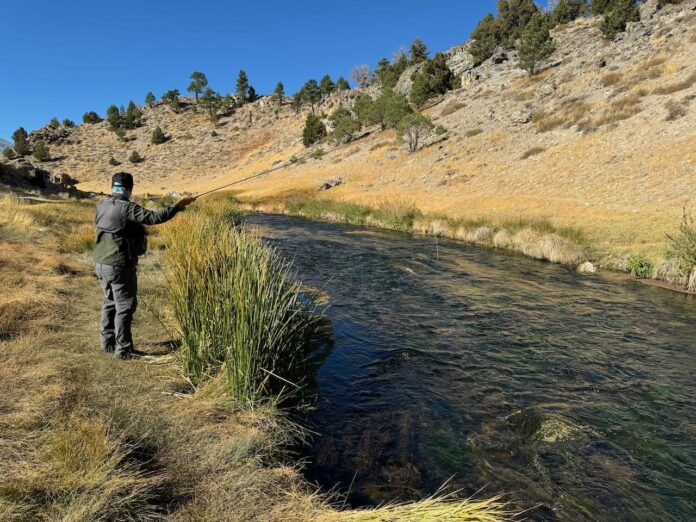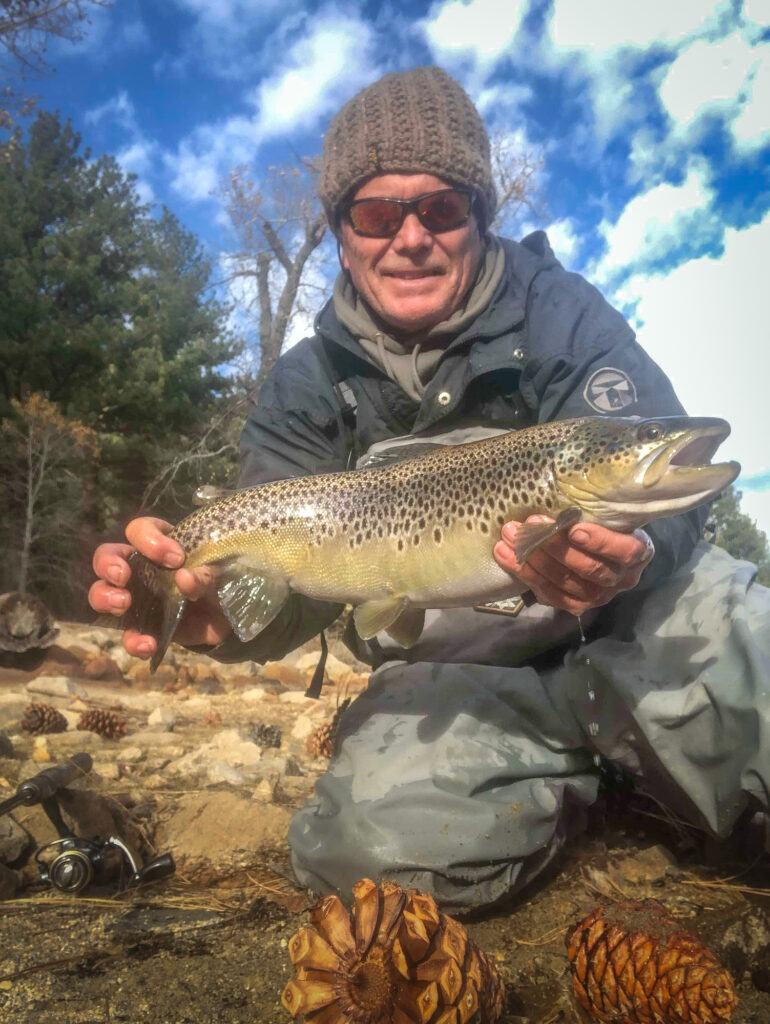
BY ERNIE COWAN
BRIDGEPORT—California’s glorious Eastern Sierra general trout season ends on Nov. 15, but anglers don’t have to shelve their gear until spring, thanks to exciting opportunities available for winter fishing.
While anglers didn’t see any trophy wallhangers in the final week of the season, Sierra waters, especially those around Bridgeport provided lots of smiles with a steady stream of bigger brown trout.
Other waters, such as Crowley Lake, the East Walker River, Silver and Grant lakes also produced their share of beautiful browns as fall weather chilled the High Country.
The cutthroat also came alive at June Lake and Crowley Lake, along with energized trophy rainbows that filled Sierra waters, thanks to the stocking efforts of local landings, tackle shops and trout anglers.
This is all good news as the general season closed with lakes and creeks in great condition and chock-full of trout. If the Sierra receives at least a normal amount of snowpack this winter, anglers can look forward to a great 2025 general season.
Trout hunting fanatics can now shift to winter fishing, and their first task is to carefully read the regulations as they are different, depending on where you are fishing. Most winter fishing waters have zero limits and require barbless, artificial lures only with no scents added, but that’s not the case everywhere.
In general, the most popular winter fishing spots include the Lower Owens River, including the Wild Trout Section, Pleasant Valley Reservoir, the Upper Owens River above Crowley Lake and Hot Creek.
It’s important to note that the East Walker River in Bridgeport is permanently closed to winter fishing, but other area waters open include the West Walker River, Robinson Creek, Green Creek, Virginia Creek, Buckeye Creek, Little Walker River, Rock Creek, McGee Creek (upstream from US 395), Lee Vining Creek (From the Lee Vining conduit upstream.)
It’s too early to have reports from winter anglers, but all those waters were well stocked with trophy rainbows, along with DFW trout prior to the end of the general season.
Some wild Sierra Lakes, and that means those with no services or resorts, are open to winter fishing, but don’t see much activity due to the difficulty of reaching them through a winter snowpack.
It’s important to remember that sudden storms, deep snow, impassable mud, ice and sometimes below zero temperatures can await winter anglers. This means you must keep track of approaching weather and be prepared with the right clothing and modes of travel, including 4×4 vehicles and even better, snowmobiles.
Many winter anglers heading out for the first time will enlist the services of a qualified guide who has the experience and equipment to reach the hot spots.
Winter tactics are also very different from summer fishing, so a day with a guide can be money well spent.
Winter fishing can also be incredibly rewarding with scenery unlike anything seen in the summer and the challenge of winter weather and terrain to land some incredible fish.
WON reached out to two guides who know winter fishing well and asked them for their outlook for the next month and for some tips on tactics and fly choice.

Doug Rodricks with Sierra Drifters said he is already booking drift boat trips on the Lower Owens, since flows are now down to around 195 cfs. He said the river is in excellent condition because heavy summer flows flushed things out.
With flows still at that level, fish are holding in slower water along the edges and in the eddies, and that should change as the fish spread out when flows begin to slow down.
Rodricks works streamers in the mornings on the Lower Owens but shifts to Blue-Wing Olives to match the afternoon hatch.
“Due to staffing issues, DFW halted stocking on the Lower Owens until early December, so for now, our focus will be on the Upper Owens where some of the bigger Crowley Lake rainbows have already moved up into the river,” Rodricks said.
Those trophy rainbows are still scattered but are holding in the bends and deeper pools.
Rodricks suggests egg patterns, San Juan Worms and Pheasant Tails.
A prime winter water is Hot Creek, east of Mammoth Lakes.
Flows here are still very low, and the thick weed beds have not died off, but soon will.
Rodricks said some browns are moving into the creek to spawn, with water a bit better near the interpretive site.
He suggests small micro midges, standard egg patterns and midges, but keep an eye out for the afternoon Blue Wing Olive hatch.
Every guide has their own secrets for success.
Fred Rowe with Sierra Bright Dot Guide Service said he is seeing trout feeding on midges and mayflies.
“On the right days there will be dry fly activity, but nymphing will be the most productive method,” Rowe said.
Weather conditions during the chilly winter months are always a bit more mile in the Lower Owen Valley and Roe said the Wild Trout Section will be the most productive water to fly fish now that water flows have receded and are expected to stay low through the winter months.
“Nymphing with Blue Wing Olive mayfly nymphs, midges and Stonefly nymphs will be producing the bulk of the trout for fly fishers. Always carry a few BWO dry flies and caddis for those days when the trout are feeding on the surface in the middle of the day,” Rowe said.
Tactics for winter fish are also a bit different. The general wisdom is slow and small, meaning very slow retrieves, slow approaches to likely spots and small flies.
While that does work, Rodricks also advocates for slower and bigger on the Upper Owens.
“Smaller will work, but the bigger trout will also take offerings like size 14 San Juan Worms or streamers,” Rodricks said.
Guides all agree that winter fishing is also better if you are using more flash and color.



